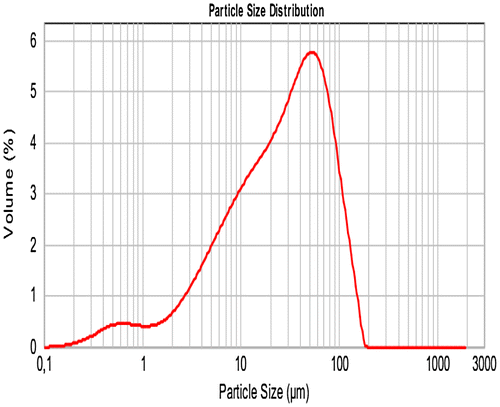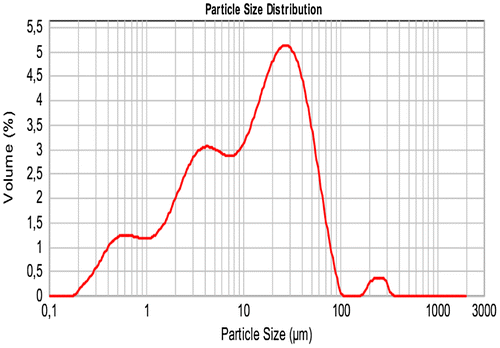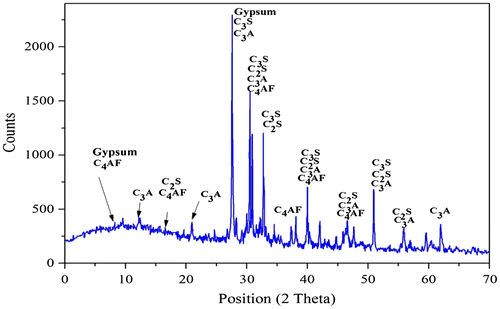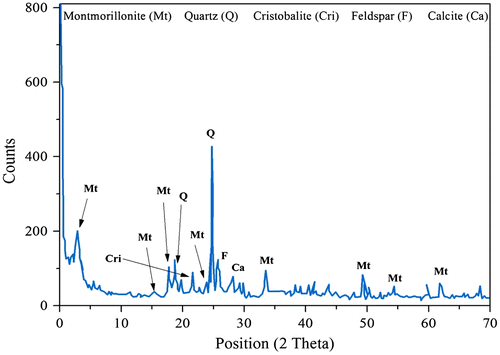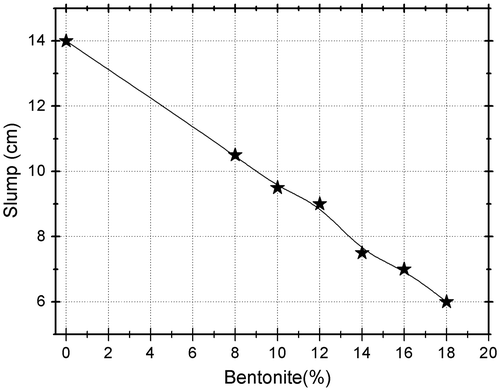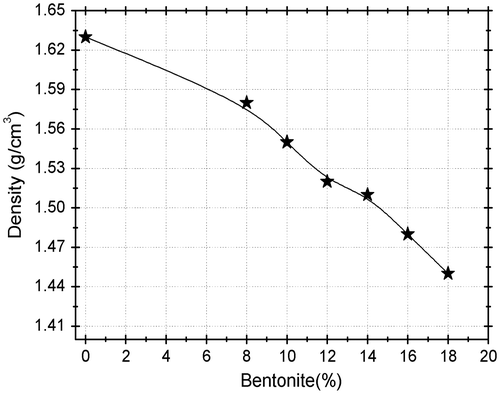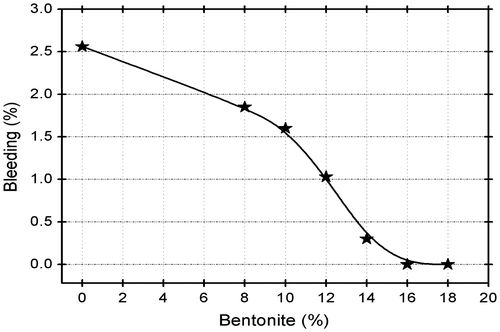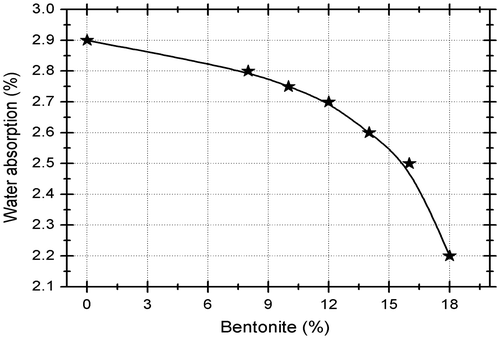Abstract
Cement-based grouts have been used successfully to repair cracks in many concrete structures, to ensure the stability of slopes or retaining walls and to reinforce soils or rock foundations. This study aims to the use of Algerian bentonite in cement grout as a partial replacement for cement. We have optimized the fresh state of cement grouts made from binary binders, by studying their physical and rheological properties. So as to analyze the effect of bentonite on the behavior of the grout, various tests such as X-ray diffraction (XRD), laser granulometry, and X-ray fluorescence spectrometry(XRF) of cement and bentonite have been investigated. This paper examines the effect of bentonite on the fresh and hardened of cement based grouts so as to develop a flow and stable grout. The experimental procedure consists to study the behaviour of mixtures substituted by different bentonite contents (8, 10, 12, 14, 16 and 18%) subjected to physical (density and bleeding), and Rheological (mini-slump cone) tests. Mechanical strength test of the hardened grouts was analysed at 28 days. Results show the compressive strength decreased slightly with increasing bentonite dosage.The assess of pozzolanic activity was determined from the strength activity index (SAI). All the mixtures have shown that the strength activity indices were higher than 75%, which were conform to the ASTM C618 standard
Public Interest Statement
In order to limit greenhouse gases and reduce energy consumption related to cement production. It is imperative to find a low-cost natural pozzolan to partially replace the cement. In this article, a natural pozzolan named Algerian bentonite is used to evaluate his performances in partial replacement of cement in cement grouts. This experimental work compares the properties of cement grouts with and without bentonite. Results of the investigation show clearly that it is possible to use the Algerian bentonite in the formulations of cement grouts. Its valorization permits to contribute to the protection of the environment.
1. Introduction
The reinforcement of soils or treatment of natural instabilities requires a major consumption of cement. Most cement plants consume large amounts of energy that releases large amounts of the greenhouse gas into the atmosphere and produce a number of undesirable products which negatively affect the environment which causes the greenhouse effect and acid rain (Ghrici, Kenai, & Meziane, Citation2006). Currently, cement producers manufacture cement containing mineral additives, namely limestone, natural pozzolana, and slag so as to reduce energy consumption and CO2 emissions. These last years, several efforts have been made for the use of pozzolanic materials as substitutes for Portland cement in many applications because of their advantageous properties which include, reduction of the environmental impact, low permeability, and good chemical resistance (Aggarwal, Singh, & Aggarwal, Citation2015; Awang & Aljoumaily, Citation2017; Lima-Guerra, Mello, Resende, & Silva, Citation2014; Rashad, Citation2013). Bentonite, a natural pozzolana, is colloidal clay was originally found in Fort Benton, Eastern Wyoming in the United States. The bentonite deposits are volcanic and hydrothermal origin, it is composed primarily of montmorillonite(smectite group) [(Al,Mg)2(OH)2(Si, Al)4O10(Ca)x·n H2O], it is associated with it is associated with other minerals such as quartz, mica, feldspar, and calcite other minerals such as quartz, mica, feldspar, and calcite. Chemically, bentonite is considered as a hydrous aluminium silicate or alumino silicates. From the point of view of structural, montmorillonites belonging to smectite group are composed of two tetrahedral sheets(Si-O) framing an octahedral sheet (Al–O–OH) (Gungor & Karaoglan, Citation2001). The particles of montmorillonite have a net negative charge. There are several types of bentonites which are generally divided into sodium bentonite with a high swelling capacity, calcium bentonite (low swelling), and calcium-sodium bentonite (medium swelling). The commercial importance of bentonite depends more on its physico–chemical properties rather than its chemical composition. They are extensively used in several sectors of industry, namely in drilling fluids (Benyounes & Benmounah, Citation2016; Benyounes, Mellak, & Benchabane, Citation2010), dyes (Günister, Alemdar, & Güngör, Citation2004), pharmaceutical applications (Lagaly & Ziesmer, Citation2003), paper (Penner & Lagaly, Citation2001), cement and ceramics (Abu-Jdayil, Citation2011), to modify the rheology and control the stability of the liquid system. The most important market for bentonite is in the civil engineering techniques, especially in the sealing of buildings, dams construction, pipe laying, building tunnels, injection of underground voids that one wishes to fill, the realization of special foundations (diaphragm walls, barrettes, piles). The Knowledge of the rheological behavior of these systems is of extreme importance in the engineering field. Owing to its rheological properties, bentonite has a thixotropic behavior. A small amount of bentonite blended with cement in aqueous solution forms a viscous mixture (Sonebi, Hughes, Harley, & Lynch, Citation2012). The apparent viscosity of cement grout decreases when the applied shear rate increases (Benyounes & Benmounah, Citation2014). The water absorption of mortar containing Pakistani bentonite decreased up to 30% clay and then steadily increased at greater bentonite loadings (Ahmad, Barbhuiya, Elahi, & Iqbal, Citation2011). The rise in the content of bentonite in cement-based grouts led to the increase of flow time, plate cohesion meter, and rheological parameters (yield stress and plastic viscosity) while decreasing the mini-slump (Sonebi et al., Citation2012). Bentonite absorbs water and can help to control bleeding and prevent segregation. However, bleeding is affected by the reduction in gel and viscosity and promote the settlement of cement solids (Domone & Jefferis, Citation2002). The use of natural bentonite and organo-bentonite as partial replacement of cement in concrete has been studied (Lima-Guerra et al., Citation2014), the introduction of bentonite as partial cement substitutions in concrete shown that the consistence, workability, density of concrete and water adsorption/absorption decreased. Bleeding is a phenomenon which can engender some consequences such as the reducing of the mobility and the pumpability of the grout (Azadi, Taghichian, & Taheri, Citation2017). Three types of chemical additives such as sodium silicate, sodium carbonate, and triethanolamine were tested to optimize the composition of cement grouts, it was found that the use 2–3% bentonite has permitted to reduce the bleeding of cement grout (Azadi et al., Citation2017). The objective of this paper consists to study the performance of a local sodium bentonite as partial replacements of cement, all by highlighting the influence of bentonite contents on the physical and rheological parameters on the cement grouts.
2. Experimental study
Portland cement (CEM-II 42.5N) conforming with European Standards EN FN 196-1 (AFNOR, Citation2006), similar to ASTM C150 Type I cement (ASTM, Citation2012) was used in the experimental study. The specific gravity of the cement was 3.15. Initial and final setting times of the cement were 170 and 265 min, respectively. The Blaine specific surface area was 3545 cm2/g and C3A content of Portland cement was 7.1%. The bentonite samples were passing through 60 μm sieve. Bentonite (see Figure ) is characterized according to EN 197-1 (Citation2011). This standard specifies that the reactive SiO2 content shall be not less than 25% by weight and bentonite samples used in this research satisfied this requirement.
For this investigation, seven various mixtures were prepared. These include one control mix which was prepared without addition of bentonite and the remaining six mixtures were prepared with different dosages of bentonite as replacement of CEM II in cement-grouts. Several grout mixes have been made with different contents of bentonite (8, 10, 12, 14, 16 and 18%) in replacement mode by weight of cement. The chemical composition of bentonite and cement is performed by X-ray fluorescence technique. Chemical analysis is a direct method for assessing the composition of the samples as a percentage of oxides. All experiments in this work were performed on the same batch of bentonite. Table shows the chemical composition, physical and mechanical properties of bentonite and cement. The samples preparation for compressive strength tests was carried out at room temperature. The specimens were prepared and cast into 40 × 40 × 40 mm3 moulds. After 24 h of curing, grout samples were immediately demoulded and then cured under tap water up to 28 days. Mechanical measurements were tested with 3R RP 3000 XP compression machine with a maximum load capacity of 3,000 kN.
Table 1. Chemical, physical and mechanical proprieties of cement and bentonite
3. Results and discussion
3.1. Particle size analysis by laser diffraction
Laser granulometry is a technique created in the 1970s. In general, granulometry allows determining the particle sizes. The laser granulometry permits measurement of sizes between 0.05 and 900 μm, which is much more accurate than with the sieving technique. Figures and show the evolution of volumeas a function of particle size, the bentonite and cement display dissimilar distribution profiles with an asymmetric distribution of particles. The particle size varies between 0.2 and 200 μm for bentonite, the particle size range for cement is 0.2 to 100 μm. The surface weighted mean is 2.973 and 6.327 um for bentonite and CEM II, respectively. These results show clearly that bentonite has a higher amount of fine particles in comparison to CEM II.
3.2. X-ray diffraction analysis
X-ray diffraction is particularly suitable for the study of the structure of crystalline materials. In XRD spectra, the strongest lines correspond to reflections perpendicular to the planes of sheets and thus are representative of d001. To better define the mineralogical composition of materials, we need to determine the nature and quantity of the various impurities contained therein. Their quantification is difficult. Some of them are abundant while others are barely detectable by X-ray. The diffractogram was obtained from the disoriented samples (placed directly in powder form into a conventional sample holder). The resulting spectrum of the crude samples gives us information on impurities and other constituents present. The XRD result of cement and bentonite are shown in Figures and . The diffractograms show several peaks, which proves that the samples are not pure and contains several impurities.
Figure shows the X-ray diffraction pattern which allows identifying various mineralogical phases contained in the Portland cement. Several peaks appear on the diffractogram of CEM II at different intensities, which can be attributed presumably to C3S alite (2θ = 30° and 32°), C2S and C4AF (2θ = 14°, 22°, 32° and 40°) and Celite C3A (main line at 2θ = 15° and 32°).
There is a main reflection and this corresponds to the mineral of montmorillonite. Some peaks have been identified as impurities. The X-ray diffraction pattern of bentonite (Figure ) shows the major phase of montmorillonite whose the main peak is at 2θ = 20° and 35°. The presence of Quartz at 2θ = 21° and 27° is noted. A peak of 2θ = 30° appears on the sample with a different intensity, which can be attributed, presumably, to calcite. The reflection at 2θ = 28° on the Maghnia clay proves the presence of sodium feldspar.
3.3. Characterization of fresh grouts
The rheological characteristics of the cement slurry can vary notably according to the test temperature or the test time after mixing. For this reason, it is necessary to apply the same protocol with grout before performing the measurements. Therefore, all the measurements at the fresh and hardened state were accomplished at room temperature.
3.3.1. Mini-slump cone
This test consists of measuring the slump diameter of grout on a horizontal plate depending on the variation of various parameters such as time, amount of water or the composition of the grout.
After the end of mixing, the grout is introduced immediately into the mini cone (Figure (a)). A few seconds later, the cone is lifted and, after stabilization, the measurement of the spread (average of two perpendicular measurements) is performed (Figure (b)).
The main advantages of this test are the ease of implementation and low material requirements (the volumeof the cone is less than 40 ml, the upper diameter is 2 cm, the lower diameter is 4 cm and the height is 6 cm).
The mini slump values for the mixtures made with different percentages of bentonite (8, 10, 12, 14, 16 and 18%) and cement II are illustrated in Figure . The addition of bentonite for a content varying between of 8% at 18% leads to the reduction of the fluidity of cement grout. This is due to the large specific surface of Blaine of bentonite and also to the exceptional structure of bentonite. These results are in agreement with other studies (Lima-Guerra et al., Citation2014; Wang & Wang, Citation2015).
On the one hand, the clay particles have tendency to absorb much water which is trapped in the interfolliar space, this will prevent the lubrication of particles, on the other hand, the montmorillonite particles are flat platelets and in fact form two modes of structures, i.e. “card-house” and “card-pack” (Van Olphen, Citation1977). The degree of the formation of these structures depends very much on the chemical nature the pH of bentonite suspension (Benna, Kbir-Ariguib, Magnin, & Bergaya, Citation1999). This microstructure of the complex system will not promote the good fluidity of cement grout.
3.3.2. Fresh density of grouts
The density of the grouts is measured using a scale that is widely used in construction provides a reliable parameter. The balance consists of a graduated arm with a covered tank witness the constant volume.
The results of the fresh density of different samples are shown in Figure . It can be observed that the density of sample without bentonite is maximum,1.63 g/cm3. The density decreases with the introduction of bentonite as a replacement for cement. It should be noted that the higher the bentonite content, the density is reduced. This is due to the fact that the density of cement grout depends on the specific gravity of solids (bentonite and cement). Since the specific gravity of cement is greater as compared to bentonite, therefore, the density of the control mix is highest.The lower density is an advantage of the bentonite binder over the CEM II, which can be used for lightweight grout.
3.3.3. Bleeding test
A grout is considered stable when the final bleeding is less than 5% after 120 min (Tan, Zaimoglu, Hinislioglu, & Altun, Citation2005). Freshly mixed grouts are evaluated for its final bleeding in a glass graduated cylinder following the procedure in ASTM C 940 (ASTM, Citation2016). An absence of sedimentation and low exudation leads to the stability and homogenization of the cement slurry. The bleeding of the grout is very affected by the water/solid ratio (Huang, Citation2001). The effect of bentonite on the development of the bleeding was also measured and the effect is shown in Figure . First of all, the results obtained show that bleeding is less than 5% for all the samples, one can see that bleeding value decreases from 2 to 0% by adding bentonite (8 to 18%) to the grout mixture. Here it was found that the bleeding decreases significantly up to the concentration of 16% bentonite. Beyond this value, the bleeding totally disappears. These results are in harmony with those obtained by several authors (Gustin, Karim, & Brouwers, Citation2007; Sonebi et al., Citation2012). From the electrokinetic point of view, the zeta potential of the smectites is generally always negative in a pH range from 2 to 12 (De Kretser, Scales, & Boger, Citation1998; Duman & Tunç, Citation2009; Durán, Ramos-Tejada, Arroyo, & Gonzalez-Caballero, Citation2000; Güngör, Alemdar, Atici, & Ece, Citation2001; Günister et al., Citation2004; Isci, Guner, Ece, & Gungor, Citation2005; Ramos-Tejada, Ontiveros, del Carmen Plaza, Delgado, & Durán, Citation2003; Sondi, Biscan, & Pravdic, Citation1996). The negative mobility of the clay particles increases with pH as well as with the adsorption of anions (Viallis-Terrisse, Citation2000). The zeta potential of Portland cement has been assessed at various initial pH values, it was shown that the zeta potential of cement increases with rising pH value, this is due to higher Ca2+ contents in the Stern layer (Nägele, Citation1985). However, the zeta potential of the Portland cement was always positive. The values for the zeta potential of cement are considered near to the unstable zone (Talero, Pedrajas, & Rahhal, Citation2013). Based on the values of the zeta potential of cement and bentonite, it can be considered that the complex cement/bentonite fluid in an aqueous medium possesses a net negative zeta potential dominated by the bentonite particles. Under these conditions, these are the repulsive forces that prevail over the van der Waals forces, which give them certain stability, this leads to the decrease of the bleeding (Figure ). The fineness of the grains and the colloidal properties of bentonite improve the stability of grout.
3.4. Characterization of hardened grouts
3.4.1. Water absorption
Water absorption is an important index of the durability of hardened cementitious materials. The reduce of water absorption can substantially improve the long term performance and lifetime of cementitious materials in aggressive conditions. Figure shows the results of the water absorption for hardened grouts with and without bentonite at 28 days of age. Bentonite particles result in improved particle packing, resulting in denser cement grout. Use of bentonite as a partial replacement for cement also results in lowering the volumeof voids in the cement blends. The water absorption diminished with rising bentonite dosage for the following reasons: (i) microparticles of bentonite which act as a filler to fill the micropores, because the particle size of this one is less than that of CEM II (see Section 3.1), (ii) the formation of additional C–S–H products by the pozzolanic reaction leading to the diminishing of voids volume(Mirza et al., Citation2009) and (iii) reduced water binder ratio. Memon et al. (Citation2012) also found that water absorption decreased with the bentonite content up to 21%, this is in agreement with our results.
3.4.2. Compressive strength of cement grouts
The compressive strength is a parameter that is very commonly used for the quality control of cementitious materials. The results of compressive strength of the mixes for 28 days are summarized in Table . The compressive strength of the cement grouts containing bentonite ranged from 28.16 to 26.43 MPa at the age of 28 days. From these values, it can be seen that the cement grouts containing bentonite have slightly lower compressive strength compared to the control grout. The results analysis of compressive strength showed that at the age of 28 days, the mixes containing bentonite showed the 0.07, 0.21, 0.24, 1.52, 2.34, and 6.14% decrease compared to control grout. These results are in good agreement with the literature (Abali, Bayca, & Targan, Citation2006; Ahmad et al., Citation2011; Mirza et al., Citation2009; Targan, Olgun, Erdogan, & Sevinc, Citation2002).
Table 2. Compressive strength of grouts and strength activity index at 28 days
The strength activity index (SAI) at 28 days can be assessed in order to evaluate the pozzolanic activity of a cementitious material. The SAI was evaluated as the ratio of the compressive strength of cement grout with bentonite to the strength of cement grout without bentonite at the same age, as the percentage. When the value of SAI exceeds 75% at 28-days, the pozzolan is considered as active according to ASTM Standard C618. SAI results presented in Table show that all the specimens have a SAI from 99.92 to 93,86% at 28 days depending the amount of bentonite in the cement grout. It can be observed that the strength activity index is slightly affected by the replacement of cement by bentonite but remains conformed to the ASTM Standard C618 specifications. The values of SAI above 75% will be ascribed to the pozzolanic reaction of active phases (silica and alumina) with the calcium hydroxide released during the cement hydration.
4. Conclusion
This experimental investigation focuses on the effect of bentonite on fresh and hardened properties of cement grout. From the obtained results of this study, the following conclusions can be drawn:
| • | The granulometric results show clearly that bentonite has a higher amount of fine particles in comparison to cement. | ||||
| • | The XRD patterns of the samples (cement and bentonite) possessed crystalline phases; we also note that the bentonite contains several impurities. | ||||
| • | The results reveal that the slump decreased as the OPC replacement by natural bentonite increased, this constitutes a disadvantage but it can be remedied by the use of a superplasticizer to improve the fluidity of the grout. | ||||
| • | Density results also indicated that the natural bentonite had a marked effect on the density of grout mixtures that make it attractive for use as a lightweight cementitious material. | ||||
| • | As a result of bleeding test, a bentonite content of 16% is selected as an optimum dosage to produce a stable grout without sedimentation and bleeding. | ||||
| • | Concerning the hardened-state properties, the water absorption of the grout decreased with increasing bentonite content. The minimum value is recorded for 18% content of bentonite. | ||||
| • | When bentonite was introduced to cement blended, the compressive strength of the grout decreased slightly with increasing bentonite content, whereas the values of strength activity index are compliant with ASTM Standard C618. | ||||
Results of the investigation indicate clearly that it is possible to use the grout formulations containing the bentonite, as a partial replacement of cement. Therefore, a replacement up to 18% cement by bentonite produces economical grouts with reasonable physical properties.
Funding
The authors received no direct funding for this research.
Additional information
Notes on contributors
Noureddine Mesboua
Noureddine Mesboua is currently pursuing his PhD in Faculty of Engineering, University M’Hamed Bougara of Boumerdes. His current research interests focus on the fiber-reinforced mortar and use of calcined clays as supplementary cementitious materials.
Khaled Benyounes
Khaled Benyounes is working as a lecturer in Faculty of Hydrocarbon and Chemistry, University M’Hamed Bougara of Boumerdes. His research interests include rheology of cement grouts, geotechnical engineering and geomechanics, self-compacting concrete, and use of calcined clays as supplementary cementitious materials.
Abdelbaki Benmounah
Abdelbaki Benmounah is working as Professor in Faculty of Engineering, University M’Hamed Bougara of Boumerdes. His research interests are high-performance concrete, self-compacting concrete, ultra-high performance fiber reinforced concrete, and use of nano-materials in concrete.
References
- Abali, Y. , Bayca, S. U. , & Targan, S. (2006). Evaluation of blends tincal waste, volcanic tuff, bentonite and fly ash for use as a cement admixture. Journal of Hazardous Materials , 131 (1–3), 126–130. doi:10.1016/j.jhazmat.2005.09.031
- Abu-Jdayil, B. (2011). Rheology of sodium and calcium bentonite–water dispersions: Effect of electrolytes and aging time. International Journal of Mineral Processing , 98 (3–4), 208–213. doi:10.1016/j.minpro.2011.01.001
- AFNOR . (2006). NF EN 196-1. Methods of testing cement – Part 1: Determination of strength .
- Aggarwal, P. , Singh, R. P. , & Aggarwal, Y. (2015). Use of nano-silica in cement based materials – A review. Cogent Engineering , 2 (1). doi:10.1080/23311916.2015.1078018
- Ahmad, S. , Barbhuiya, S. , Elahi, A. , & Iqbal, J. (2011). Effect of Pakistani bentonite on properties of mortar and concrete. Clay Minerals , 46 (1), 85–92.10.1180/claymin.2011.046.1.85
- ASTM . (2012). Standard specification for portland cement . ASTM C 150/C150M-15 (p. 2015). West Conshohocken, PA: ASTM International.
- ASTM . (2016). Standard test method for expansion and bleeding of freshly mixed grouts for preplaced-aggregate concrete in the laboratory, ASTM C940–16 . West Conshohocken, PA: ASTM International.
- Awang, H. , & Aljoumaily, Z. S. (2017). Influence of granulated blast furnace slag on mechanical properties of foam concrete. Cogent Engineering , 4 (1). doi:10.1080/23311916.2017.1409853
- Azadi, M. R. , Taghichian, A. , & Taheri, A. (2017). Optimization of cement-based grouts using chemical additives. Journal of Rock Mechanics and Geotechnical Engineering , 9 (4), 623–637. doi:10.1016/j.jrmge.2016.11.013
- Benna, M. , Kbir-Ariguib, N. , Magnin, A. , & Bergaya, F. (1999). Effect of pH on rheological properties of purified sodium bentonite suspensions. Journal of Colloid and Interface Science , 218 (2), 442–455.10.1006/jcis.1999.6420
- Benyounes, K. , & Benmounah, A. (2014). Effect of bentonite on the rheological behavior of cement grout in presence of superplasticizer. International Journal of Civil, Architectural, Structural and Construction Engineering , 8 (11), 1095–1098.
- Benyounes, K. , & Benmounah, A. (2016). Rheological and electrokinetic characterization of bentonite particles in aqueous phase in presence of KCl. Particulate Science and Technology , 34 (1), 39–44.10.1080/02726351.2015.1042563
- Benyounes, K. , Mellak, A. , & Benchabane, A. (2010). The effect of carboxymethylcellulose and xanthan on the rheology of bentonite suspensions. Energy Sources, Part A: Recovery, Utilization, and Environmental Effects , 32 (17), 1634–1643.10.1080/15567030902842244
- De Kretser, R. G. , Scales, P. J. , & Boger, D. V. (1998). Surface chemistry-rheology inter-relationships in clay suspensions. Colloids and Surfaces A: Physicochemical and Engineering Aspects , 137 (1–3), 307–318.10.1016/S0927-7757(97)00372-5
- Domone, P. , & Jefferis, S. A. (2002). Structural grouts . London: CRC Press.
- Duman, O. , & Tunç, S. (2009). Electrokinetic and rheological properties of Na-bentonite in some electrolyte solutions. Microporous and Mesoporous Materials , 117 (1–2), 331–338. doi:10.1016/j.micromeso.2008.07.007
- Durán, J. D. G. , Ramos-Tejada, M. M. , Arroyo, F. J. , & Gonzalez-Caballero, F. (2000). Rheological and electrokinetic properties of sodium montmorillonite suspensions. Journal of Colloid and Interface Science , 229 (1), 107–117.10.1006/jcis.2000.6956
- EN . (2011). EN 197-1. Cement-part 1: Composition, specifications and conformity criteria for common cements . Brussels: European Committee for Standardization.
- Ghrici, M. , Kenai, S. , & Meziane, E. (2006). Mechanical and durability properties of cement mortar with Algerian natural pozzolana. Journal of Materials Science , 41 (21), 6965–6972.10.1007/s10853-006-0227-0
- Güngör, N. , Alemdar, A. , Atici, O. , & Ece, I. O. (2001). The effect of SDS surfactant on the flow and zeta potential of bentonite suspensions. Materials Letters , 51 (3), 250–254.
- Gungor, N. , & Karaoglan, S. (2001). Interactions of polyacrylamide polymer with bentonite in aqueous systems. Materials Letters , 48 (3–4), 168–175.10.1016/S0167-577X(00)00298-6
- Günister, E. , Alemdar, S. , & Güngör, N. (2004). Effect of sodium dodecyl sulfate on flow and electrokinetic properties of Na-activated bentonite dispersions. Bulletin of Materials Science , 27 (3), 317–322. doi:10.1007/BF02708522
- Gustin, E. , Karim, U. , & Brouwers, H. (2007). Bleeding characteristics for viscous cement and cement-bentonite grouts. Geotechnique , 57 (4), 391–395.10.1680/geot.2007.57.4.391
- Huang, W.-H. (2001). Improving the properties of cement–fly ash grout using fiber and superplasticizer. Cement and Concrete Research , 31 (7), 1033–1041. doi:10.1016/S0008-8846(01)00527-0
- Isci, S. , Guner, F. S. , Ece, O. I. , & Gungor, N. (2005). Investigation of rheological and collodial properties of bentonitic clay dispersion in the presence of a cationic surfactant. Progress in Organic Coatings , 54 (1), 28–33.10.1016/j.porgcoat.2005.03.002
- Lagaly, G. , & Ziesmer, S. (2003). Colloid chemistry of clay minerals: The coagulation of montmorillonite dispersions. Advances in Colloid and Interface Science , 100–102 , 105–128.10.1016/S0001-8686(02)00064-7
- Lima-Guerra, D. J. , Mello, I. , Resende, R. , & Silva, R. (2014). Use of bentonite and organobentonite as alternatives of partial substitution of cement in concrete manufacturing. International Journal of Concrete Structures and Materials , 8 (1), 15–26. doi:10.1007/s40069-013-0066-8
- Memon, S. A. , Arsalan, R. , Khan, S. , & Lo, T. Y. (2012). Utilization of Pakistani bentonite as partial replacement of cement in concrete. Construction and Building Materials , 30 , 237–242. doi:10.1016/j.conbuildmat.2011.11.021
- Mirza, J. , Riaz, M. , Naseer, A. , Rehman, F. , Khan, A. N. , & Ali, Q. (2009). Pakistani bentonite in mortars and concrete as low cost construction material. Applied Clay Science , 45 (4), 220–226. doi:10.1016/j.clay.2009.06.011
- Nägele, E. (1985). The zeta-potential of cement. Cement and Concrete Research , 15 (3), 453–462. doi:10.1016/0008-8846(85)90118-8
- Penner, D. , & Lagaly, G. (2001). Influence of anions on the rheological properties of clay mineral dispersions. Applied Clay Science , 19 (1–6), 131–142.10.1016/S0169-1317(01)00052-7
- Ramos-Tejada, M. M. , Ontiveros, A. , del Carmen Plaza, R. , Delgado, A. V. , & Durán, J. D. G. (2003). A rheological approach to the stability of humic acid/clay colloidal suspensions. Rheologica Acta , 42 (1–2), 148–157.10.1007/s00397-002-0266-7
- Rashad, A. M. (2013). Metakaolin as cementitious material: History, scours, production and composition – A comprehensive overview. Construction and Building Materials , 41 , 303–318. doi:10.1016/j.conbuildmat.2012.12.001
- Sondi, I. , Biscan, J. , & Pravdic, V. (1996). Electrokinetics of pure clay minerals revisited. Journal of Colloid and Interface Science , 178 (2), 514–522.10.1006/jcis.1996.0146
- Sonebi, M. , Hughes, D. , Harley, R. , & Lynch, K. (2012). Characterisation of the performance of sustainable grout containing bentonite for geotechnical applications . Paper presented at the International conference on Sustainable Built Environment for Now and the Future, Hanoi, Vietnam
- Talero, R. , Pedrajas, C. , & Rahhal, V. (2013). Performance of fresh Portland cement pastes–determination of some specific rheological parameters Rheology-New concepts, applications and methods (pp. 57–79). Rijeka: InTech.
- Tan, O. , Zaimoglu, A. S. , Hinislioglu, S. , & Altun, S. (2005). Taguchi approach for optimization of the bleeding on cement-based grouts. Tunnelling and Underground Space Technology , 20 (2), 167–173.10.1016/j.tust.2004.08.004
- Targan, Ş. , Olgun, A. , Erdogan, Y. , & Sevinc, V. (2002). Effects of supplementary cementing materials on the properties of cement and concrete. Cement and Concrete Research , 32 (10), 1551–1558. doi:10.1016/S0008-8846(02)00831-1
- Van Olphen, H. (1977). An introduction to clay colloid chemistry (2nd ed.). New York, NY : Wiley.
- Viallis-Terrisse, H. (2000). Interaction des Silicates de Calcium Hydratés, principaux constituants du ciment, avec les chlorures d’alcalins. Analogie avec les argiles [Interaction of Hydrated Calcium Silicates, main constituents of cement, with alkali chlorides. Analogy with clays] (PhD). Université de Bourgogne.
- Wang, L. , & Wang, D. (2015). Effects of clay on properties of polycarboxylate superplasticizer and solutions. Journal of Wuhan University of Technology-Materials Science Edition , 30 (6), 1167–1171. 10.1007/s11595-015-1290-7


